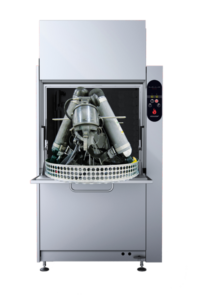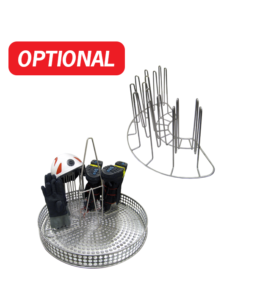Sponsored content by RESCUE Intellitech
By: Robert Avsec, Executive Fire Officer
What’s the most important piece of equipment on any piece of fire apparatus? If you answered “The firefighters” move to the head of the class.
Now for the follow-up question: What’s the second most important piece? But of course, the SCBA (self-contained breathing apparatus)! That’s the single piece of equipment that’s going to protect that firefighter when they must enter an IDLH (immediately dangerous to life and health) atmosphere, atmospheres they encounter during:
- Interior structural firefighting;
- Hazardous materials releases or spills;
- Emergencies below grade (e.g., sewers or tunnels); and
- Emergencies in confined spaces (e.g., tanks, vessels).
During these types of events, and particularly during interior structural firefighting, the SCBA unit can be exposed to a toxic “soup” of chemicals, chemical compounds, and known carcinogens while it protects the firefighter’s respiratory system from those same hazards.
And while much is currently being discussed and written about how to protect firefighters from those hazards, there is much to be learned about how to keep SCBA units clean and decontaminated after each use and ready for the next emergency.
Today’s SCBA technology
The original SCBA units of 50 years ago were little more than a tank of compressed air, a regulator, a mask, and a backpack harness to  put it all on a firefighter. Think “caveman-level” technology.
put it all on a firefighter. Think “caveman-level” technology.
The current generation of SCBA is more “Star Wars” or “Transformers” technology with enhanced electronics using Bluetooth® technology computerized electronics integrated into SCBA that (depending upon the manufacturer) supports wireless connectivity between devices for improved configurability, data transmission/retrieval, firefighter safety and fireground accountability. Today’s SCBA for firefighting tasks has features (depending upon the manufacturer and model) that include:
- Monitoring the user’s air consumption in real-time along with their rate of air consumption;
- Integrated PASS (personal alarm safety system) that transmits an alarm if the firefighter becomes motionless for any reason;
- Visual and audible alerts to notify the incident commander of a high-flow condition (e.g., heavy breathing or free flow) or no-flow condition from a firefighter’s SCBA during a full-alarm PASS activation.
- In-the-mask features such as communications and thermal imaging capability;
- Wireless, bi-directional communication between a firefighter and the incident command for better fireground accountability and communications; and
- Visual and audible alerts to notify the firefighter and incident commander of impending electronics degradation due to elevated temperature.
Cleaning technology to match the SCBA’s technology
One thing that has not kept pace with the advances in SCBA technology is the cleaning and decontamination of SCBA following

“After washing our packs [for the test] I suggested we gather and wash all the spare packs and then work to rotate our entire inventory through the machine. I know it will take a while due to the dry time but, after seeing how much gunk was cleaned off our packs, I think it is needed.”
Lt. Eric Welch – Pearland (Tex.) Fire Department
emergency operations, especially following interior structural firefighting. Before the days of exposure to the toxic chemicals, chemical compounds, carcinogens, and soot, aka, the “toxic soup” produced by today’s structure fires, SCBA could be adequately cleaned with a good soft-bristle brush, a bucket of soapy water, and a water hose to provide the final rinse.
But that’s no longer the case. That “toxic soup” has become more lethal as the production of building materials and building furnishings has steadily moved from natural materials towards synthetic materials (many of which are petroleum-based). Also, the fire service is learning more about the connection between that exposure on the fireground and the increased risk for firefighters to develop cancer from occupational exposure.
Today’s SCBA cleaning and decontamination challenge is this: How to be both efficient and effective at removing those toxic materials—particularly soot particles—from what has become a very complex piece of equipment with both mechanical and electronic components?
Enter the Solo Rescue® SCBA Decon Washer from Sweden-based RESCUE Intellitech AB. The unique Solo Rescue® system features a rotating basket that enables the water jets to reach and decontaminate even tight and sometimes hard to reach spaces, such as between the back plate and the air cylinder. So, when it comes to cleaning and decontaminating soiled SCBA, the Solo Rescue® system gives your fire department the tool to:
- Reduced health risk because there’s no need to disassemble the SCBA unit. Using a Solo Rescue®heavy duty washing machine prevents exposing the crew to combustion gases, soot particles, and toxins released in the cleaning and decontamination process.
- Save time. Thoroughly cleaning one SCBA unit by hand can take a half an hour or more depending upon the level of cleaning and decontamination necessary. The Solo Rescue® takes less than eight minutes to complete its cleaning and decontamination process. You can clean your entire fire company’s used SCBA in less than an hour!
- Easy to use. Simply load your equipment, choose one of two wash programs (SCBA or gloves/helmets), and push the START button!
More about that glove and helmet wash program. You likely have a washer/extractor that’s designed to clean the firefighter protective coat and trousers, right? But how are you cleaning the other components of the firefighter protective ensemble (e.g., helmet, gloves, boots)?
The Solo Rescue® can handle that task with an optional insert for use in cleaning glove, helmet, and firefighting boots. The washer can accommodate one or two of the inserts which provide cleaning capacity for:

“Currently, the washing capabilities for helmets is somewhat limited for fire departments in North America. This is mainly due to the design of “American Helmets” (e.g., a wide brim, leather cladding and very large badges) that tend to be a hinderance for machine washing). We are presently working on a solution.”
Per Liberg, Business Area Manager, RESCUE INTELLITECH Inc.
- Helmets (maximum of five helmets/insert)
- Up to 60 helmets/hour (using one insert)
- Up to 100 helmets/hour (using two inserts)
- Gloves
- Up to 80 pairs of gloves/hour (using one insert)
- Up to 160 pairs of gloves/hour (using two inserts)
- Boots
- Up to 30 pairs of boots (using one insert)
- Up to 60 pairs of boots (using two inserts)
So, isn’t it time for your cleaning and decontamination equipment and process to leave the “caveman era” and move into the “Star Wars era?”
 Fire & EMS Leader Pro The job of old firefighters is to teach young firefighters how to become old firefighters!
Fire & EMS Leader Pro The job of old firefighters is to teach young firefighters how to become old firefighters!